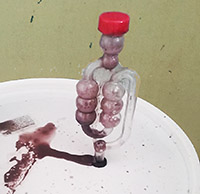Does your Wine Need an Airlock During Primary Fermentation?
Posted by Matteo Lahm on 3rd Apr 2023
If you’ve ever started a batch and found the airlock filled with wine the next day, you know how much of a mess it can cause. The use of airlocks during primary fermentation for wine is a common practice among home winemakers but there are a few things to consider. First and foremost, wine cannot oxidize with high fermentation activity. You need an airlock for oxidation after it calms down. So if you don't need an airlock to protect your wine from oxidation, why use one?
The short answer is that you want to protect your wine from environmental contaminants. Air has dust and dirt and there is the ongoing menace of fruit flies. Juice is loaded with sugar and that attracts unwanted visitors. When you prep your batch and pitch your yeast, it is best to keep your fermenter closed until things start happening.
There is also the issue of what else is in your fermentation space. Many home winemakers use basements or garages. There are lots of things in those spaces that could produce off flavors in your wine. Cleaners, paints, lawn equipment, gas, motor oil and dryer lint are common co-occupants. If you use your kitchen, bread yeasts are a big menace. You want to make sure your wine does not come in contact with anything that will compromise its flavor or the yeast. You would be amazed at how easily wine can absorb flavors from other substances. You do not want your wine to have aftertastes of simple green cleaner or bleach. You are always one dominant bread yeast away from a problem. Therefore, covers and airlocks are about cleanliness and sanitation before and during peak primary.

The carbon dioxide gas from yeast activity creates an upward pressure that prevents oxygen from entering your vessel. If you were to guess just how much CO2 is produced, you would probably lowball it. It’s a lot! The amount of carbon dioxide gas depends on the size of the batch but at the peak of fermentation, a six-gallon batch produces approximately 0.5 liters of carbon dioxide gas per hour! If your peak fermentation phase lasts two days, that is over six gallons of CO2. The upward flow of the carbon dioxide gas is more than sufficient to prevent oxygen from getting into your wine and it is not only the pressure. Carbon dioxide gas is heavier than oxygen and creates a barrier that prevents it from entering. Additionally, carbon dioxide gas is released in a continuous stream. If you could see it, it would look like one of Gomez and Morticia’s cocktails bubbling over the glass in an episode of the Adams Family.
At the very least, your fermentation vessel should be sufficiently covered during high fermentation activity. If you are using a bucket with a lid that has an airlock hole, if you don't want to use an airlock, at least cover the hole on top of the bucket. Rest the cover on top at all times except when you are stirring or punching down a must cap. On a carboy, as long as you have enough headspace to accommodate yeast activity, you can let your airlock bubble away. If you don't have enough space, use a blow off tube and a secondary bucket. Worst case scenario, use a carboy cap and cover the holes with cheese cloth. The most important thing is that you prevent dust particles from being able to settle in your wine. It is hard to fight against what you can't see but unfortunately, that is most of what you are up against.
When fermentation starts to calm down, that is when you should start worrying about oxidation. You should have an airlock or blowoff tube when you reach the last 1/3 of the sugars. At that point, fermentation is much less active. The wine will not swell up into your airlock because it is producing a lot less CO2. From there on out, you absolutely want a closed environment. But if you do insist on an airlock throughout the entire process, the new Blue Bullet Airlock is best suited to primary because of its size. It holds 3-4 times the amount of water and can handle more aggressive fermentation activity.
In conclusion, it is important to know why airlocks and closed containers matter at various parts of the process. That way you know what you need to worry about and what you don't. You can also save yourself some unnecessary clean up. It won't hurt your wine if it pushes up in the airlock but it can make quite a mess and airlock water can be a bit gross. Water exposed to air can start growing bacteria in just a few hours. If you want to be extra cautious, use vodka in your airlock or add just a pinch of sulfites to the water. The more you protect your wine, the higher the likelihood of a good result, and no problems. Good luck!

